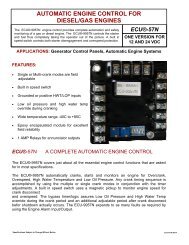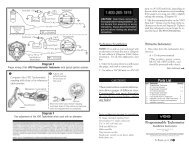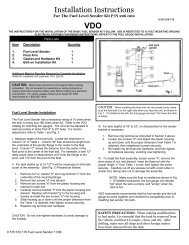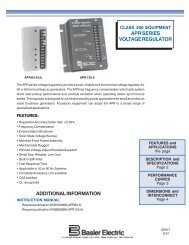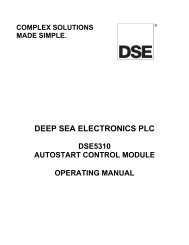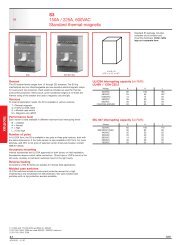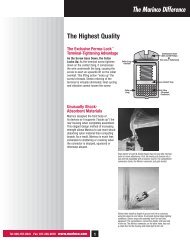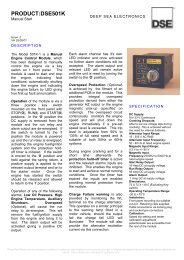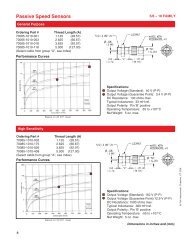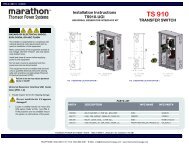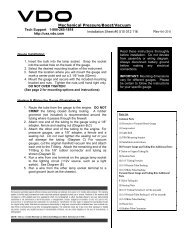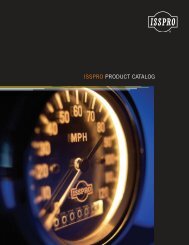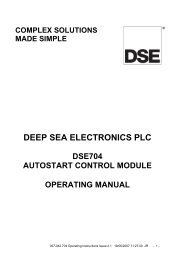Korfund Elastomeric Isolator Catalog - Davidson Sales Co.
Korfund Elastomeric Isolator Catalog - Davidson Sales Co.
Korfund Elastomeric Isolator Catalog - Davidson Sales Co.
Create successful ePaper yourself
Turn your PDF publications into a flip-book with our unique Google optimized e-Paper software.
ELASTOMERICMOUNTSTECHNOTESlisted in usually one but sometimes two “standard”materials. To meet specifics of temperature, extremestrength, enhanced damping, chemical resistance andresistance to ozone and sunlight we can provide manyother materials. With few exceptions, we can mold anymount in our product line in any material that can bemolded. Our manufacturing process is set up so thatwe can produce short run specials sometimes at thesame cost, or with a very slight premium. VMC shouldbe consulted whenever environment is suspected tobe an issue. We offer here some guidelines to ourmost commonly used materials.Neoprene and Neoprene Blends – Good generalpurpose black-rubber for sustained operatingtemperatures between -40 o and +180 o F. Resistantto splashes of most oils and hydraulic fluid andother conditions typical of industrial and enginecompartment environments. Our standard materialfor most industrial mounts.VMC <strong>Co</strong>lor-coded Neoprene and BlendedMaterials – Good general purpose rubber for mostmoderate service conditions. Particularly favored in theHVAC industry because the material can be colorcoded to indicate mount rating and stiffness. Our standardin our R/RD line and pads.Silicone – Provides increased operating temperaturerange of -60 o to +300 o F. Inherently resistant to manychemicals, with the exception of lubricating oil. Lowoutgassing. For this reason it is favored for military andspace applications. Overall, silicone provides greaterdynamic damping than many other materials. It alsocan be color coded to indicate load capacity.VMC Weather-Resistant (WR) Blended Material –Similar to our color-coded neoprene and blendedmaterials, it offers the same color coding to indicateload rating. Upper limit on service temperature isextended to +250 o F and has greater resistance to sunlight(UV) ozone, salt water and acids. For this reason itmay be preferred when extreme outdoor conditionsare encountered such as on exposed rooftops insome locations.EPDM – A good substitute for our neoprene, blendedand color-coded materials when extended temperaturerange, improved chemical resistance or low-temperatureflexibility is needed.VMC Extreme High Temperature Silicone – Capableof continuous operation to +485 o F.VMC High Damped Silicone – Capable of producingmounts with dynamic damping factors approaching25% of critical depending on type of input.Other Specialty Materials – Fluorosilicone,Fluorocarbon, ECO, HNBR, Polyacrylates and naturalrubber to name just a few.<strong>Elastomeric</strong> mounts will inherently provide somedegree of dynamic damping. Damping limits responsepeaks when a machine momentarily passes throughresonance such as during start-up. It limits ringing dueto shocks and transients. Damping is a property of thematerial and also affected by the character of thedynamic input. It is velocity dependent so high frequency,large displacement inputs will result in proportionallythe greatest damping out of a given material.Damping operates by drawing energy out of the systemin the form of heat. Damped mounts will warmwith operation. In the extreme case, heavily dampedmounts operated for extended periods of time undersevere conditions or near resonance will overheat. Thiswill shorten the mount’s overall service life. The level ofdamping should be appropriate to the application.Above all else, mounts should not be operated in aresonance condition for extended periods of time. Inmost industrial applications, the moderate amount ofdamping provided by our standard materials combinedwith operation well above suspension resonance willprovide excellent performance and service life. Certainmilitary applications necessitate high damping materialsin order to control broad-spectrum random vibrationand shock. The use of high damping material mustbe combined with good engineering analysis and testingparticularly when the suspension natural frequencymust reside within a narrow band. Damping makes themount appear stiffer dynamically.Nitrile – Generally a good substitute for our neoprene,blended and color-coded materials when significantexposure to oils and hydraulic fluids are present.Vibration Mountings & <strong>Co</strong>ntrols, Inc. 603



